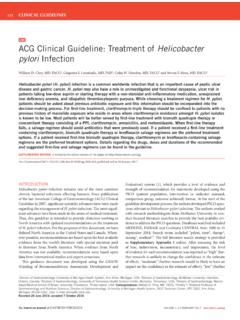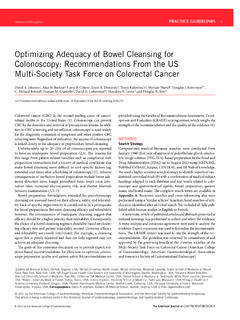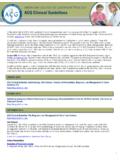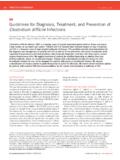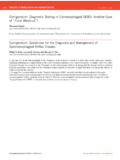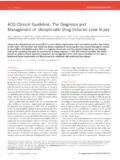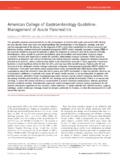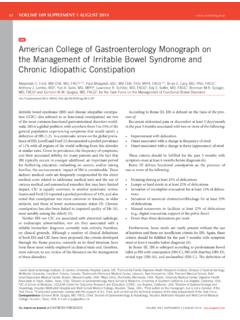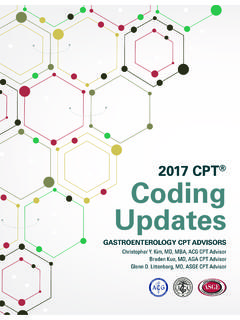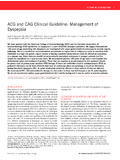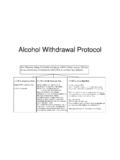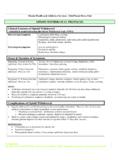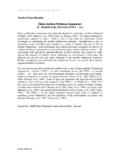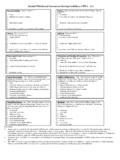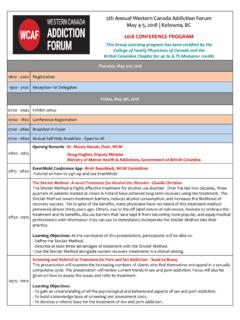Transcription of ACG Clinical Guideline: Alcoholic Liver Disease
1 Clinical GUIDELINES 1. ACG Clinical Guideline: Alcoholic Liver Disease Ashwani K. Singal, MD, MS, FACG1, Ramon Bataller, MD, PhD, FACG2, Joseph Ahn, MD, MS, FACG (GRADE Methodologist)3, Patrick S. Kamath, MD4 and Vijay H. Shah, MD, FACG4. Alcoholic Liver Disease (ALD) comprises a Clinical -histologic spectrum including fatty Liver , Alcoholic hepatitis (AH), and cirrhosis with its complications. Most patients are diagnosed at advanced stages and data on the prevalence and pro le of patients with early Disease are limited. Diagnosis of ALD requires documentation of chronic heavy alcohol use and exclusion of other causes of Liver Disease . Prolonged abstinence is the most effective strategy to prevent Disease progression. AH presents with rapid onset or worsening of jaundice, and in severe cases may transition to acute on chronic Liver failure when the risk for mortality, depending on the number of extra-hepatic organ failures, may be as high as 20 50% at 1 month.
2 Corticosteroids provide short-term survival bene t in about half of treated patients with severe AH and long-term mortality is related to severity of underlying Liver Disease and is dependent on abstinence from alcohol. General measures in patients hospitalized with ALD include inpatient management of Liver Disease complications, management of alcohol withdrawal syndrome, surveillance for infections and early effective antibiotic therapy, nutritional supplementation, and treatment of the underlying alcohol-use disorder. Liver transplantation, a de nitive treatment option in patients with advanced Alcoholic cirrhosis, may also be considered in selected patients with AH cases, who do not respond to medical therapy. There is a Clinical unmet need to develop more effective and safer therapies for patients with ALD. Am J Gastroenterol advance online publication, 16 January 2018; INTRODUCTION sive tools to diagnose ALD at early stages and promising pharma- Alcoholic Liver Disease (ALD) is one of the main causes of chronic cological approaches for Alcoholic hepatitis (AH) are still needed.
3 Liver Disease worldwide and accounts for up to 48% of cirrhosis- Finally, recent studies suggest that early Liver transplantation (LT). associated deaths in the United States (1). Alcohol is also a fre- can be successfully performed in highly selected patients with AH. quent co-factor in patients with other type of Liver Disease such The authors were invited by the Board of Trustees and Practice as hepatitis C virus (HCV) infection where it accelerates hepatic Parameters Committee of the American College of Gastroenterol- fibrosis (2). Owing to various susceptibility factors, individuals ogy, to develop this practice guideline document on the manage- with long-term heavy alcohol use remain at risk for advanced Liver ment of patients with ALD. Disease with Alcoholic steatohepatitis (ASH), cirrhosis, and hepa- Key concepts on ALD and specific recommendations have been tocellular carcinoma (HCC) (3). Most patients with ALD present developed for specialists in Liver Disease , gastroenterologists, and for medical care after they have developed jaundice or complica- primary care providers, to aid them in the management of ALD.
4 Tions of cirrhosis (4). Identification of ALD in the primary-care patients. Recommendations based on Population Intervention setting at an early stage and subsequent behavioral interventions Comparison Outcome format/Grading of Recommendations should thus be encouraged. Compared with the recent advances in Assessment, Development, and Evaluation analysis are in Table 1. viral hepatitis, few pharmacological advances have been made in These recommendations and guidelines should be tailored to indi- the management of patients with ALD. To date, the most effective vidual patients and circumstances in routine Clinical practice. Key therapy to attenuate the Clinical course of ALD and even reverse concepts and recommendations based on author expert opinion Liver damage is prolonged alcohol abstinence (5,6). Given its high and review of literature are in Table 2. prevalence and economic burden, ALD is receiving increasing To develop these guidelines, a search was performed on the Ovid attention by health authorities, research funding organizations, search platform: Epub Ahead of Print, In-Process and Other Non- and the Liver academic community.
5 Nevertheless, novel non-inva- Indexed Citations, Ovid MEDLINE (R) Daily and Ovid MEDLINE. 1. Division of Gastroenterology and Hepatology, University of Alabama at Birmingham School of Medicine, Birmingham, Alabama, USA; 2 Division of Gastroenterology, Hepatology and Nutrition, University of Pittsburgh Liver Research Center, Pittsburgh, Pennsylvania, USA; 3 Division of Gastroenterology and Hepatology, Oregon Health and Science University, Portland, Oregon, USA; 4 Division of Gastroenterology and Hepatology, Mayo Clinic, Rochester, Minnesota, USA. Correspondence: Vijay H. Shah, MD, FACG, Division of Gastroenterology and Hepatology, Mayo Clinic, 200 1st Street SW, Rochester, Minnesota 55905, USA. E-mail: Received 20 July 2017; accepted 8 November 2017. 2018 by the American College of Gastroenterology The American Journal of GASTROENTEROLOGY. 2 Singal et al. Table 1. Recommendations in the management of Alcoholic Liver Disease Environmental and genetic determinants 1.
6 Patients with obesity or chronic HCV should avoid consumption of alcohol. (Conditional recommendation, very low level of evidence). 2. Patients with ALD should be advised to abstain from cigarettes. (Conditional recommendation, very low level of evidence). Diagnosis of Alcoholic use disorder 3. Patients who have heavy alcohol use (>3 drinks per day in men and >2 drinks in women) for >5 years) should be counseled that they are at increased risk for Alcoholic Liver Disease . (Strong recommendation, low level of evidence). Management of Alcoholic Liver Disease Management of alcohol use disorder 4. In patients with ALD, baclofen is effective in preventing alcohol relapse (Conditional recommendation, low level of evidence). 5. In patients with ALD, brief motivational interventions are effective in reducing alcohol relapse compared with no intervention (Conditional recommenda- tion, very low level of evidence). Alcoholic hepatitis Treatment of Alcoholic hepatitis 6.
7 Patients with AH should be considered for nutritional supplementation to ensure adequate caloric intake and to correct speci c de cits, yet its effects on patient survival has not been proven (Conditional recommendation, very low level of evidence). 7. Patients with severe AH should be treated with corticosteroids if there are no contraindications for their use (Strong recommendation, moderate level of evidence). 8. The existing evidence does not support the use of pentoxifylline for patients with severe AH. (Conditional recommendation, low level of evidence). Liver transplantation in Alcoholic Liver Disease 9. Liver transplantation may be considered for highly selected patients with severe AH (Strong recommendation, moderate level of evidence). (R), EBM Reviews Cochrane Central Registry of Controlled Trials, ing (defined by the National Institute of Alcoholism and Alcohol EMBASE, and PsycInfo for the period 1980 through July 2016. A Abuse as >5 drinks in males and >4 drinks in females, consumed combination of database-specific subject headings ( , MEDLINE over 2 h period) (7).)
8 In the United States, one drink is defined as a Liver Diseases and Alcoholic ) and text words (Alcohol* (truncated) beverage containing about 14 g of alcohol, which is present in 12. within three words of Liver , or hepat* (truncation) or cirrho* (trun- ounces of beer (5% weight/volume) or 5 ounces of wine (8 10%. cation)) in association with LT (subject's headings plus text words). weight/volume), or ounces of hard liquor (40 45% weight/vol- The results were downloaded from each database into EndNote ume) (7). Economic costs due to AUD (249 billion USD per year). X7 and duplicates removed. To evaluate the level of evidence and are increasing. An estimated 88,000 people (~62,000 men and strength of recommendations, we used the Grading of Recom- 26,000 women) die from alcohol-related causes annually, making mendations Assessment, Development, and Evaluation system, as alcohol the fourth leading preventable cause of death in the United suggested by the American College of Gastroenterology Practice States (8).
9 Apart from ALD, accidents or violence are other com- Parameters Committee. The strength of recommendation is graded mon causes of death among adult people abusing alcohol. In 2014, as strong or conditional as a consensus among the authors, consid- alcohol-impaired driving fatalities accounted for 9,967 deaths in ering the weight of desirable and undesirable effects of intervention. the United States (31% of overall driving fatalities) (1). The level of evidence was determined independently of the authors The association between alcohol and Liver -related mortality is and designated as high, moderate, low, and very low, considering strongly supported by data showing a linear relationship between the confidence in the effect estimate based on current literature. the standard Liver death rate and overall alcohol consumption in many countries (9,10). Importantly, drinking patterns such as heavy episodic drinking vs. heavy daily use and the type of alcohol EPIDEMIOLOGY AND Disease BURDEN consumed may not independently predict the alcohol-attributable Alcohol-use disorder (AUD) is one of the main causes of prevent- fraction of cirrhosis (11).
10 However, designation of countries by able Disease and Liver Disease -associated mortality in the United moderate or heavy daily drinking most clearly demonstrates the States and worldwide. A recent report from the World Health weight of alcohol on the cirrhosis burden (10). The Disease burden Organization indicates that million deaths (6% of all global of alcohol is rapidly increasing in Asian countries such as China, deaths) are attributable to alcohol use, and that alcohol abuse is a Korea, and India. There are also regional differences in Europe risk factor in about 50% of cases of cirrhosis (1). Approximately 1 between Eastern and Western Europe, likely to be due to imple- in 12 adults have AUD defined as consumption of >3 drinks per mentation of policy measures leading to decrease in alcohol use in day in males and >2 drinks per day in females, or binge drink- many areas of Western Europe. The American Journal of GASTROENTEROLOGY VOLUME XXX | XXX 2017 Alcoholic Liver Disease 3.
